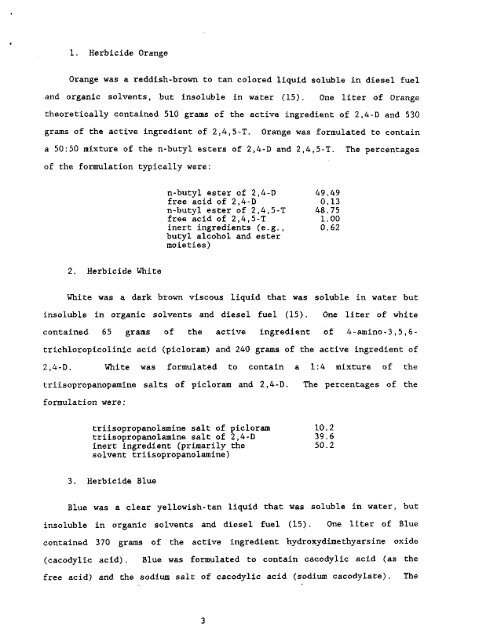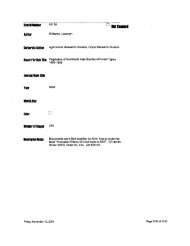Chapter 2: The Military Use of Herbicides in Vietnam - Special ...
Chapter 2: The Military Use of Herbicides in Vietnam - Special ...
Chapter 2: The Military Use of Herbicides in Vietnam - Special ...
Create successful ePaper yourself
Turn your PDF publications into a flip-book with our unique Google optimized e-Paper software.
1. Herbicide Orange<br />
Orange was a reddish-brown to tan colored liquid soluble <strong>in</strong> diesel fuel<br />
and organic solvents, but <strong>in</strong>soluble <strong>in</strong> water (15). One liter <strong>of</strong> Orange<br />
theoretically conta<strong>in</strong>ed 510 grams <strong>of</strong> the active <strong>in</strong>gredient <strong>of</strong> 2,4-D and 530<br />
grams <strong>of</strong> the active <strong>in</strong>gredient <strong>of</strong> 2,4,5-T.<br />
Orange was formulated to conta<strong>in</strong><br />
a 50:50 mixture <strong>of</strong> the n-butyl esters <strong>of</strong> 2,4-D and 2,4,5-T. <strong>The</strong> percentages<br />
<strong>of</strong> the formulation typically were:<br />
2. Herbicide White<br />
n-butyl ester <strong>of</strong> 2,4-D 49.49<br />
free acid <strong>of</strong> 2,4-D 0.13<br />
n-butyl ester <strong>of</strong> 2,4,5-T 48.75<br />
free acid <strong>of</strong> 2,4,5-T 1.00<br />
<strong>in</strong>ert <strong>in</strong>gredients (e.g., 0.62<br />
butyl alcohol and ester<br />
moieties)<br />
White was a dark brown viscous liquid that was soluble <strong>in</strong> water but<br />
<strong>in</strong>soluble <strong>in</strong> organic solvents and diesel fuel (15).<br />
One liter <strong>of</strong> white<br />
conta<strong>in</strong>ed 65 grams <strong>of</strong> the active <strong>in</strong>gredient <strong>of</strong> 4-am<strong>in</strong>o-3,5,6-<br />
trichloropicol<strong>in</strong>ic acid (picloram) and 240 grams <strong>of</strong> the active <strong>in</strong>gredient <strong>of</strong><br />
2,4-D. White was formulated to conta<strong>in</strong> a 1:4 mixture <strong>of</strong> the<br />
triisopropanopam<strong>in</strong>e salts <strong>of</strong> picloram and 2,4-D.<br />
formulation were:<br />
triisopropanolam<strong>in</strong>e salt <strong>of</strong> picloram 10.2<br />
triisopropanolam<strong>in</strong>e salt <strong>of</strong> 2,4-D 39.6<br />
<strong>in</strong>ert <strong>in</strong>gredient (primarily the 50.2<br />
solvent triisopropanolam<strong>in</strong>e)<br />
3. Herbicide Blue<br />
<strong>The</strong> percentages <strong>of</strong> the<br />
Blue was a clear yellowish-tan liquid that was soluble <strong>in</strong> water, but<br />
<strong>in</strong>soluble <strong>in</strong> organic solvents and diesel fuel (15).<br />
conta<strong>in</strong>ed<br />
(cacodylic acid).<br />
One liter <strong>of</strong> Blue<br />
370 grams <strong>of</strong> the active <strong>in</strong>gredient hydroxydimethyars<strong>in</strong>e oxide<br />
Blue was formulated to conta<strong>in</strong> cacodylic acid (as the<br />
free acid) and the sodium salt <strong>of</strong> cacodylic acid (sodium cacodylate).<br />
<strong>The</strong>
















